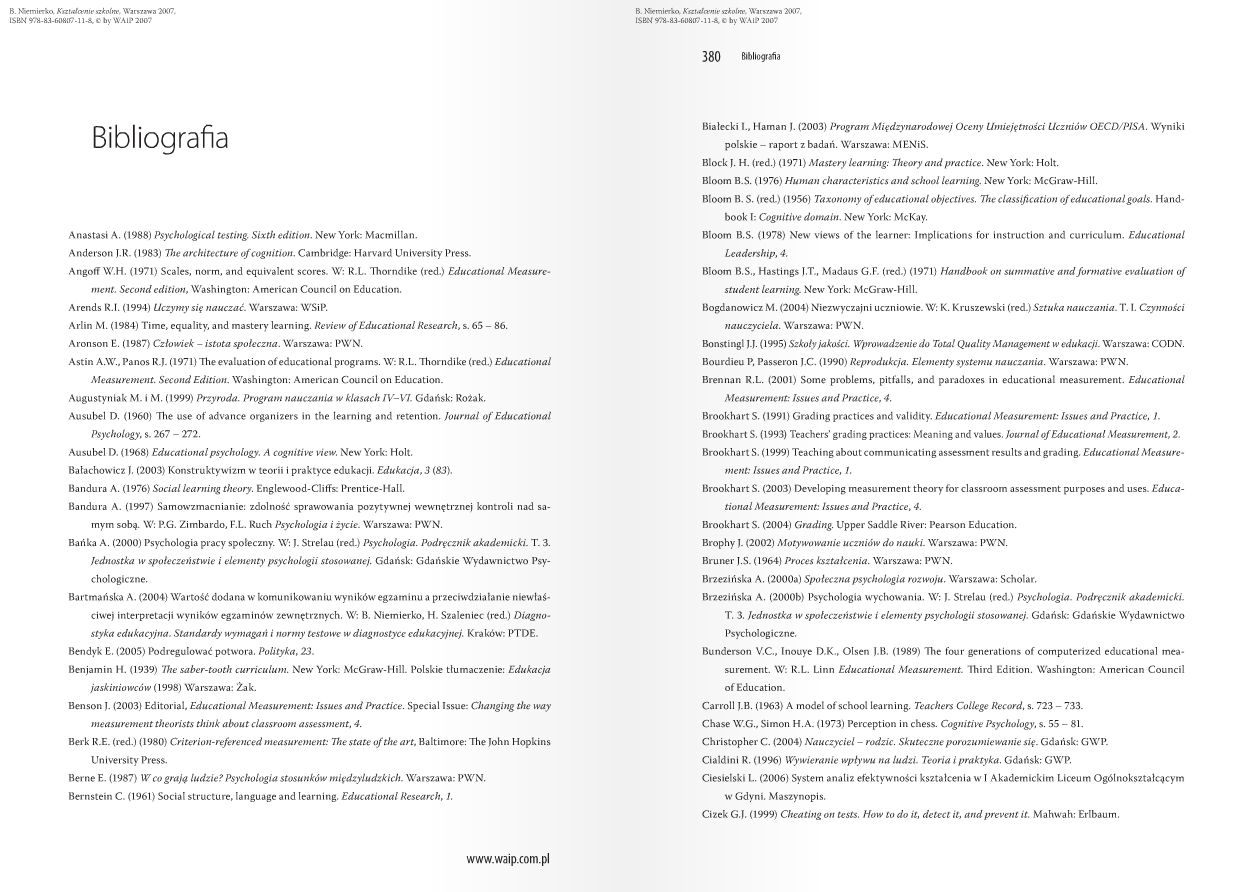image190 (7)

B t&cmitrfa fCtz\-dnn\e aMm Vbtmwa 2097. ISBN 9ra-H3-«HKfM1-A. C by WAIP2007
Bibliografia
Anastasi A. (1988) Psychotogical testmg. Sixth edition. Mew York: Macmlllan.
Anderson ].R. (1983) The archltecture ofcognition. Cambridge: Harvard Unlver$ity Press.
AngolT W.H. (1971) Scales, norm. and equivalent scorcs. W: R.L. Thorndike (red.) Educational Mcasurc-menl. Sccondcdition, Washington: American CounciI on Education.
Arcnds R.l. (1994) Uczymy się nauczać. Warszawa: WSiP.
Arlin M. (1984) Time, cąuality, and mastery learning. Reriew of Educational Research, s. 65 - 86.
Aronson E. (1987) Człowiek - istota społeczna. Warszawa: PWN.
Astin A.W., Panos RJ. (1971) The evaluation of educational programs. W: R.L. Thorndike (red.) Educational Measurement. Second Edition. Washington: American CounciI on Education.
Augustyniak M. i M. (1999) Przyroda. Program nauczania w klasach JV-VI. Gdańsk: Kozak.
Ausubel D. (1960) The use ofadvance organizers m the learning and retention. lournal of Educational Psjchology, s. 267 - 272.
Ausubel D. (1968) Educationalpsychology. A cognitior view. New York: Holt.
Balachowicz I. (2003) Konstruktywizm w teorii i praktyce edukacji. Edukacja, 3 (83).
Bandura A. (\976) Social learning theory. Englcwood-ClitTs: Prcntice-Hall.
Bandura A. (1997) Samowzmacnianic: zdolność sprawowania pozytywnej wewnętrznej kontroli nad samym sob^. W: P.G. Zimbardo, F.L. Kuch Psychologia i życie. Warszawa: PWN.
Bańka A. (2000) Psychologia pracy społeczny. W: Strelau (red.) Psychologia. Podręcznik akademicki. T. 3. Jednostka w społeczeństwie i elementy psychologii stosowanej. Gdańsk: Gdańskie Wydawnictwo Psychologiczne.
Bat tmańska A. (2004) Wartość dodana w komunikowaniu wyników egzaminu a przeciwdziałanie niewłaściwej interpretacji wyników egzaminów zewnętrznych. W: B. Niemierko, H. Szaleniec (red.) Diagnostyka edukacyjna. Standardy wymagań i normy testowe w diagnostyce edukacyjnej. Kraków: PTDE.
Bendyk E. (2005) Podregulować potwora. Polityka, 23.
Benjamin H. (1939) 'Ihe saber-tooth curriculum. New York: McGraw-Hill. Polskie tłumaczenie: Edukacja jaskiniowców (1998) Warszawa: Żak.
Benson J. 12003) Editorial. Educational Measurement: Issues and Practice. Special Issue: Changing the way measurementtheorists think about ciassroom assessment. 4.
Berk R.E. (red.) (1980) C.riterion-referenced measurement: The stale of the art. Baltimore: The John Hopkins Unlversity Press.
Benie E. (1987) W co graj# ludzie? Psychologia stosunków międzyludzkich. Warszawa: PWN.
Bernstein C. (1961) Social structure, language and learning. Educational Research, 1.
www.waip.com.pl
8 JSemitrko. Ksit-dnnw tzkotm. Wimawa 2937 ISBN 978-83-60807-11A C by WAIP 2007
380 Bibliografia
Białecki I., I laman ). (20031 Program Międzynarodowej Oceny Umiejętności Uczniów OECD/PISA. Wyniki polskie - raport z badań. Warszawa: MENiS.
Błock J. H. (red.) (1971) Matury learning: Theory and practice. New York: Holt.
Bioom B.S. (1976) Humań characteristics andschool learning. New York: McGraw-Hill.
Bloorn B. S. (red.) (19.56) Taxonomy of educational objectiees. The classifcation of educational goals. Hand-book 1: Cognitioe domain. New York: McKay.
Bioom B.S. (1978) New view$ of the learner: Impltcations for instruction and curriculum. Educational Leadcrship, 4.
Bioom B.S., Haslings J.T.. Madaus G.F. (red.) (1971) Handbook on summatioc andformaliee cvalualion of student learning. New York: McGraw-Hill.
Bogdanowicz M. (2004| Niezwyczajni uczniowie. W: K. Kruszewski (red.) Sztuka nauczania. T. I. Czynności nauczyciela. Warszawa: PWN.
Bonstingl J.J. (1995) Szkoły jakości. Wprowadzenie do Toia! Quality Management w edukacji. Warszawa: C.ODN.
Bourdieu P. Passeron J.C. (1990) Reprodukcja. Elementy systemu nauczania. Warszawa: PWN.
Brennan R.L. (2001) Some problems, pitfalls. and paradoxes in educational measurement. Educational Measurement: Issues and Practicc. 4.
Brookhart S. (1991) Grading practices and validity. Educational Measurement: Issues and Practice. I.
Brookhart S. (1993) Teachers' grading practices: Mcaningand values. Journal of Educational Measurement, 2.
Brookhart S. (1999) Teachingaboutcommunicatingasscssment resultsand grading. Educational Measurement: Issues and Practice, I.
Brookhart S. (2003) Dcveloping measurement theory for classroom assessment purposes and uses. Educational Measurement: Issues and Practice, 4.
Brookhart S. (2004) Grading. Upper Saddle River: Pearson Education.
Brophy I- (2002) Motywowanie uczniów do nauki. Warszawa: PWN.
Bruner J.S. (1964) Proces kształcenia. Warszawa: PWN.
Brzezińska A. (2000a) Społeczna psychologia rozwoju. Warszawa: Scholar.
Brzezińska A. (2000b> Psychologia wychowania. W: |. Strelau (red.) Psychologia. Podręcznik akademicki. T. 3. Jednostka w społeczeństwie i elementy psychologii stosowanej. Gdańsk: Gdańskie Wydawnictwo Psychologiczne.
Bunderson V.C., Inouye D.K., Olsen ).B. (1989) The four generations of computerized educational mca-surement. W: R.L. Linn Educational .Measurement. Ihird Edition. Washington: American CounciI of Education.
Carroll l.B. (1963) A model of school learning. Teachers College Record, s. 723 - 733.
Chase W.G., Simon H.A. (1973) Perception in chess. Cognitiw Psychołogy, s. 55-81.
Christopher C. (2004) Nauczyciel - rodzic. Skuteczne porozumiewanie się. Gdańsk: GWP.
Claldini R. (19%) Wywieranie wpływu na Judzi. Teoria i praktyka. Gdańsk: GWP.
Ciesielski I.. (2006) System analiz efektywności kształcenia w I Akademickim Liceum Ogólnokształcącym w Gdyni. Maszynopis.
Cizek G.|. (1999) Chcating on tests. How to do U, delecl ii, andpreoent it. Mahwah: Erlbautn.
Wyszukiwarka
Podobne podstrony:
image100 (11) 8. SJjrmirrio Kamlarnur aMm. Witwiwa 2CK*7. ISBN m-SU-GOKtC-ll-A. C by WAIP2007 hkam 1
image100 (11) 8. SJjrmirrio Kamlarnur aMm. Witwiwa 2CK*7. ISBN m-SU-GOKtC-ll-A. C by WAIP2007 hkam 1
image148 (5) U. Jfcemirrio. KalnIcrnur akolitę, Warw*wa 2097. ISBN WH.lU.fiMaMl-4 C by WAIP200"
image100 (11) 8. SJjrmirrio Kamlarnur aMm. Witwiwa 2CK*7. ISBN m-SU-GOKtC-ll-A. C by WAIP2007 hkam 1
image113 (10) B. Nirnunko, KctaUem sekator, Waraaw* 2007, ISBN 978-S3-«CiSCrf7•1l-8,< by WAIP200?
image150 (5) B. SŁemirrito. Kat-tlanie akptm, Wmiiwa 20fl?. ISBN 97H-H3-COiłff7-n-A. C by WAIP 200?
image191 (6) B. SJ*mirrko. Katatonie aMm. Warwiwa 2007. ISBN C by WAIP200&quo
29202 image147 (7) B. NfecmittkiOb KrzUtlame cłpfm-, Witwjwa 20(17, ISBN 97»-83-WH«f7-n-«. C by WAIP
więcej podobnych podstron